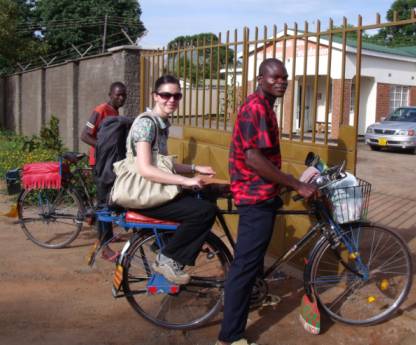In a slightly separate vein from my usual social performance management work, I’ve also been involved in setting up a partnership between MicroLoan Foundation and a local charity based in Mchinji, who focus on agricultural sustainability and food security for the most vulnerable. An agreement is being worked on whereby they provide the agricultural training and support and help groups access markets and form associations. MicroLoan will work in the same geographical area, providing its clients with loans and group dynamics/leadership training. The idea is that the most vulnerable in this area of Mchinji therefore benefit not only from better agricultural skills, but have more access to credit to buy inputs (like fertilizer) and support to market their produce more effectively after harvest.
To introduce the local charity to MicroLoan Foundation’s way of working, we went to visit a ‘tilime’ group. This is a special kind of MicroLoan group, who are given a loan not to invest in their business, but to spend on agricultural inputs. It’s made during the rainy season when most people are planting their fields. This particular group welcomed us in matching group chitenges (the colourful cloth women use as skirts) and exuberant singing and dancing! They told us that they used their loans for fertilizer to grow maize, legumes and groundnuts, and that their fields are flourishing. One lady informed us that this is her fourth loan, though her first tilime loan. With the first loan’s profits she managed to invest in a goat, with the second a bicycle, with the third she extended her house, and now she is expanding her area under cultivation with the tilime loan. The sense of group solidarity was undeniable. Recently when one member was bitten by a snake and forced to stay in hospital for a month, the remainder of the group tended her fields for her, harvested her crops and assisted her family.
.jpg)
Just thought you might be interested in a piece I wrote from Lilongwe, Malawi, for the Wausau Daily Herald called "Husband and his wife are helping an African nation farm it’s was out of poverty." I am blogging everyday from Africa and writing for the Worldwatch Institute's Nourishing the Planet blog at http://blogs.worldwatch.org/nourishingtheplanet/. Please feel free to cross-post on your site. All the best, Danielle Nierenberg
ReplyDeleteHere is the piece:
Stacia and Kristof Nordin have an unusual backyard, and it looks a lot different from the Edgar yard in which Kristof grew up.
Rather than the typical bare dirt patch of land that most Malawians sweep “clean” every day, the Nordins have more than 200 varieties of mostly indigenous vegetables growing organically around their house. They came to Malawi in 1997 as Peace Corps volunteers, but now call Malawi home. Stacia is a technical adviser to the Malawi Ministry of Education, working to sensitize both policymakers and citizens about the importance of using indigenous foods and permaculture to improve livelihoods and nutrition. Kristof is a community educator who works to train people at all levels of Malawian society in low-input and sustainable agricultural practices.
The Nordins use their home as a demonstration plot for permaculture methods that incorporate composting, water harvesting, intercropping and other methods that help build organic matter in soils, conserve water, and protect agricultural diversity. Most Malawians think of traditional foods, such as amaranth and African eggplant, as poor-people foods grown by “bad” farmers. But these crops might hold the key for solving hunger, malnutrition and poverty in Malawi — as well as in other African countries.
Nowhere needs the help more than Malawi, a nation of 14 million in southeast Africa that is among the least developed and most densely populated on Earth.
The country might be best known for the so-called “Malawi Miracle.” Five years ago, the government decided to do something controversial and provide fertilizer subsidies to farmers to grow maize. Since then, maize production has tripled and Malawi has been touted as an agricultural success story.
But the way they are refining that corn, says Kristof, makes it “kind of like Wonder Bread,” leaving it with just two or three nutrients. Traditional varieties of corn, which aren’t usually so highly processed, are more nutritious and don’t require as much artificial fertilizer as do hybrid varieties.
“Forty-eight percent of the country’s children are still nutritionally stunted, even with the so-called miracle,” Kristof says.
Rather than focusing on just planting maize — a crop that is not native to Africa — the Nordins advise farmers with whom they work that there is “no miracle plant — just plant them all.” Research has shown that Malawi has more than 600 indigenous and naturalized food plants to choose from. Maize, ironically, is one of the least suited to this region because it’s highly susceptible to pests, disease and erratic rainfall patterns.
Unfortunately, the “fixation on just one crop,” says Kristof, means that traditional varieties of foods are going extinct — crops that already are adapted to drought and heat, traits that become especially important as agriculture copes with climate change....
To read the rest of the piece, visit http://blogs.worldwatch.org/nourishingtheplanet/wausau-daily-herald-husband-and-his-wife-are-helping-an-african-nation-farm-its-was-out-of-poverty/.
Hi Deborah
ReplyDeleteGood to hear from you and really pleased you’re following the goings on here in Kasungu! Hope your son enjoys his ongoing work in Malawi, and hopefully catch up with you on your next visit in the not too distant future.
All the best
Daniella